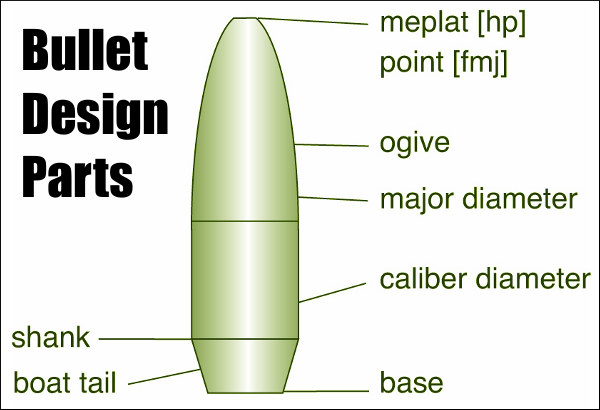Ogives, Meplats, Boat-Tails and Other Bullet Design Elements

Noted gun writer Glen Zediker (author of Top Grade Ammo), regularly contributes tech articles to the Midsouth Shooters Blog. One of Glen’s Midsouth Blog articles covers Bullet Design. We suggest you read the article — even seasoned hand-loaders will learn a few things about projectile properties (and how to choose the right bullet design for your needs). Glen also wrote a recent Blog article on cartridge pressure signs, linked below
Read Zediker Bullet Design Article | Read Zediker Pressure Signs Article
Glen explains: “A ‘match’ bullet’s job is to perforate a piece of paper. A bullet designed for varmint hunting, on the other hand, is designed to produce explosive impact, and one for larger game hunting strives to strike a balance between expansion and penetration. However! No matter how it’s built inside, there are universal elements of any bullet design, and those are found on the outside.”

In his article, Glen identifies the key elements of a bullet and explains how they are defined: “Base, that’s the bottom; boat-tail, or not (flat-base); shank, portion of full-caliber diameter; ogive, the sloping ‘nosecone'; tip, either open or closed (open it’s called the ‘meplat’). The shape of the ogive and the first point of ‘major diameter’ are extremely influential elements. The first point of major diameter can vary from barrel brand to barrel brand because it’s the point on the bullet that coincides with land diameter in the barrel — the first point that will actually contact the barrel as the bullet moves forward. When there’s a cartridge sitting in the rifle chamber, the distance or gap between the first point of major diameter and the lands is called ‘jump’, and, usually, the less there is the better.”

Ogives Analyzed — Tangent vs. Secant Bullet Designs
Glen notes that bullet designs reflect secant or tangent profiles, or a combination of both: “The two essential profiles a bullet can take are ‘secant’ and ‘tangent’. This refers to the shape of the ogive. A tangent is a more rounded, gradual flow toward the tip, while a secant is a more radical step-in, more like a spike. Secants fly with less resistance (less aerodynamic drag), but tangents are [often] more tolerant of jump [or to put it another way, less sensitive to seating depth variations].”Glen adds: “Ogives are measured in ‘calibers’. That’s pretty simple: an 8-caliber ogive describes an arc that’s 8 times caliber diameter; a 12-caliber is based on a circle that’s 12 times the caliber. The 8 will be a smaller circle than the 12, so, an 8-caliber ogive is more ‘blunt’ or rounded. Bullets with lower-caliber ogives are more tolerant of jump and (usually) shoot better, easier. Higher-caliber ogives [generally] fly better, farther. This is an important component in the ‘high-BC’ designs.”
Learn More in Zediker Books
Glen has authored a number of excellent books for hand-loaders and competitive shooters. Here are three of his most popular titles, including his latest book, Top Grade Ammo:
 |
 |
 |
All these titles are available from Midsouth Shooters Supply. Click each cover above to purchase from Midsouth.

















